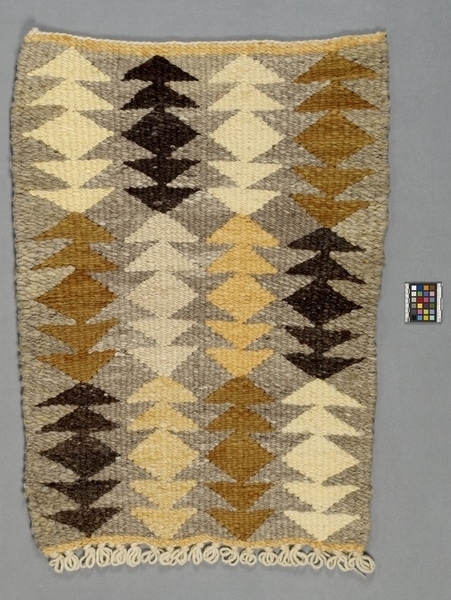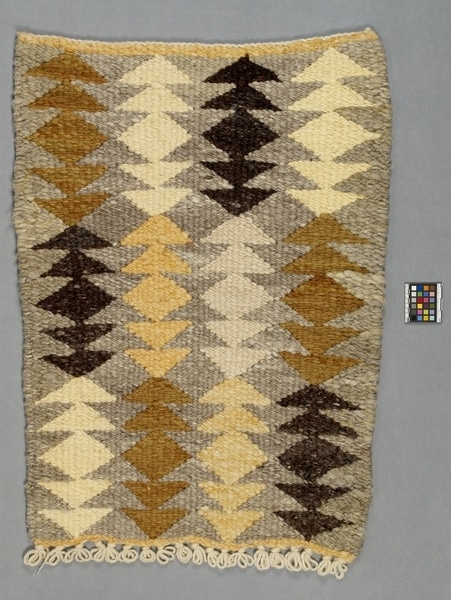Wall Hanging Item Number: Nbz779 from the MOA: University of British Columbia


Description
Rectangular wall hanging with a basic structure of discontinuous weft twining. The ground is grey with grey-yellow and grey-brown. There are four vertical rows of arrows and diamonds. The pattern consists of two arrows with a diamond in centre then two other arrows, and there are three such patterns in each row in different colours. The one-ply handspun weft has a looped finish on one end and over-hand knots on the other. The warp is five-ply machine-made wool.
History Of Use
Salish weaving is a very old tradition. Traditionally blankets of mountain goat wool were very valuable possessions, and were important wealth items. They were presented as gifts at ceremonial occasions, such as weddings, naming ceremonies, and memorials. They were also used to compensate shamans and other specialists for services. Wealthy families also wrapped their dead in the blankets. Women who wove the blankets generally had a spirit helper associated with weaving skills and would undergo ritual purification before weaving. After contact, mass produced blankets flooded onto the Northwest Coast and by the early 20th century production of tradition blankets had almost ceased. In the 1960's there was a revival of blanket weaving at Sardis, and later at Musqueam. In 1971, the Salish Weavers Guild was formed and operated out of the Coqualeetza Cultural Center until 1985. The weavers studied old blankets in museums and were aided by elders.
Iconographic Meaning
Diamond design is symbolic of love and understanding.
Cultural Context
contemporary; weaving
Specific Techniques
Sto:lo weavers noted that golden rod is used as a dye for the yellow colour. The more you use, the darker the colour becomes. The brown wool could be natural, but it is more likely a commercial dye since it is hard to get that particular shade of brown. You would have to boil the wool several times while adding cedar bark and other materials.
Item History
- Made by Monica Williams (Maker) in British Columbia, Canada between 1971 and 1977
- Collected in Chilliwack, British Columbia, Canada
- Owned by Salish Weavers before July 8, 1977
- Received from Museum of Anthropology Donations Fund (Funding source) and Salish Weavers (Seller) on July 8, 1977
What
- Name
- Wall Hanging
- Identification Number
- Nbz779
- Type of Item
- hanging
- Material
- sheep wool fibre, golden rod dye and dye
- Manufacturing Technique
- twined
- Overall
- height 117.5 cm, width 79.5 cm
Who
- Culture
- Coast Salish: Sto:lo
- Creator
- Monica Williams (Maker)
- Previous Owner
- Salish Weavers
- Received from
- Museum of Anthropology Donations Fund (Funding source) and Salish Weavers (Seller)
Where
- Holding Institution
- MOA: University of British Columbia
- Made in
- British Columbia, Canada
- Collected in
- Chilliwack, British Columbia, Canada
When
- Creation Date
- between 1971 and 1977
- Ownership Date
- before July 8, 1977
- Acquisition Date
- on July 8, 1977
Other
- Item Classes
- textiles
- Condition
- good
- Current Location
- Case 4
- Accession Number
- 0410/0001